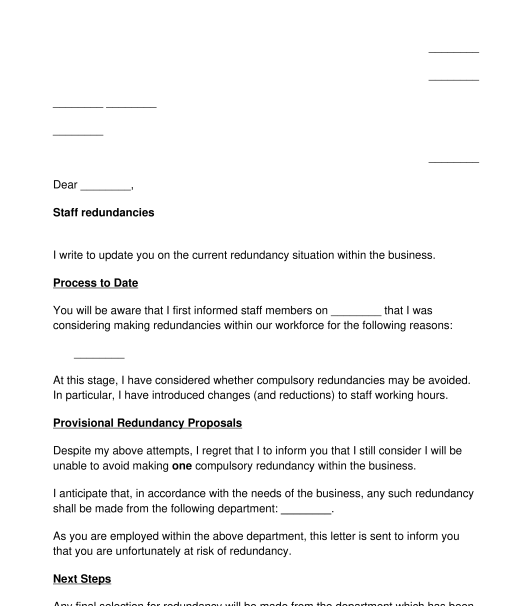 08/09/2025
08/09/2025

Answer a few questions and your document is created automatically.

Your document is ready! You will receive it in Word and PDF formats. You will be able to modify it.

 08/09/2025
08/09/2025
 Word and PDF
Word and PDF
 2 to 3 pages
2 to 3 pages
This document takes the form of a letter and may be used by employers to warn an employee that they are at risk of redundancy. The letter should be used to advise the employee of this risk, before any final redundancy selection has been made. The document is designed for use where the employee is employed within Great Britain. The document may be used where the employer is a sole trader, company, LLP or partnership.
This document is designed for use where the employer has anticipated a potential redundancy situation and has devised a provision pool or group of employees who are at risk of redundancy. The letter will:
There are number of factors which an employer is required to consider when dealing with a redundancy situation. A redundancy dismissal may only be used where a role is no longer needed because of:
The employer must always individually consult affected employees. Individual consultation should take place after any collective consultation (if applicable)*. Individual consultations may comprise of a few different meetings and could include some group meetings, but affected employees should be met with in private at least once. This letter can be used to invite the employee to an individual consultation meeting, and to provide details of the meeting.
Where an employer is making 20 or more employees redundant (within a 90 day period), it must hold a collective consultation with appropriate employee representatives. An appropriate employee representative will be any trade union which is formally recognised by the employer. Where no trade union is formally recognised, the employer must consult with employee representatives who have been elected to represent the interests of the affected employees. The collective consultation must begin at least 45 days before the first redundancy dismissal takes effect where 100 or more employees are to be made redundant. The collective consultation must begin at least 30 days before the first redundancy dismissal takes effect where less than 100 employees are to be made redundant. This letter can be sent to employees prior to the collective consultation process, or after it has concluded. More information about collective consultations can be found on the ACAS website.
The employer may hold a redundancy policy, which should be referred to throughout the redundancy process. It is also paramount that the employer does not discriminate against its employees during the redundancy process, and it may hold a specific equality policy which should then be referred to. Further information about managing employee redundancies can be found in our legal guide 'Managing Employee Redundancies'.
The letter should be completed, taking care to enter the relevant information about the redundancy proposals accurately (including all proposed redundancy numbers). Once the letter has been finalised, it should be signed either by the employer (where they are a sole trader) or by an authorised representative (where the employer is a company, LLP or partnership). It is acceptable to provide an electronic signature if so desired.
This type of letter will usually be handed to the employee in person during a meeting. The next steps will then be carried out, as set out within the letter.
If the employer concludes that compulsory redundancies cannot be avoided then, once all the relevant redundancy processes have been completed and final redundancy selections have been made, the employer will dismiss the selected employee(s) by using a final redundancy notice.
The main legal provision which governs redundancy situations is The Employment Rights Act 1996.
Some other relevant provisions are:
ACAS (the Advisory, Conciliation and Arbitration Service) also provides guidelines and advice to employers and employees in respect of redundancy.
You fill out a form. The document is created before your eyes as you respond to the questions.
At the end, you receive it in Word and PDF formats. You can modify it and reuse it.
Guides to help you
Country: United Kingdom